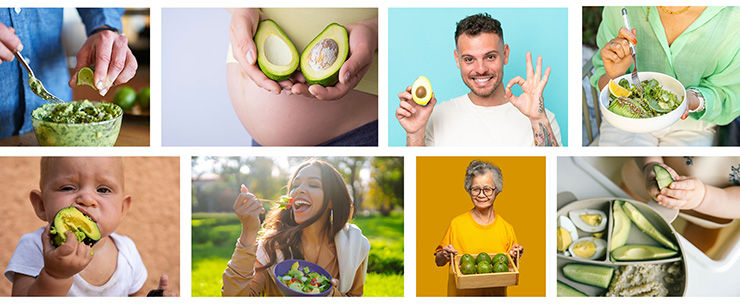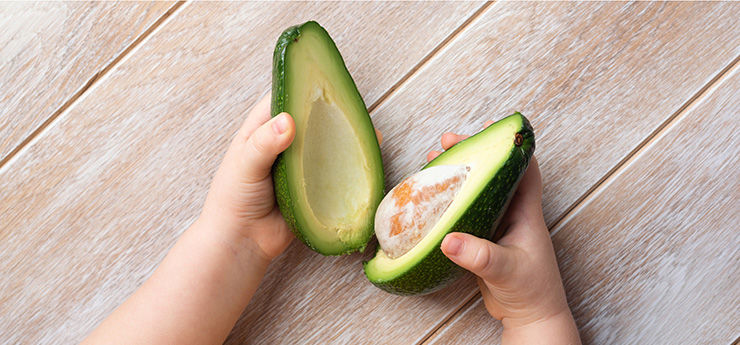Guac on! Avocadoes for all ages
- OSCAR Care Group

- Jul 24
- 7 min read
Avocado is one of the superfoods due to its high nutritional value and health benefits for people of all ages. With an earthy but neutral flavour, avocado goes well with sweet and savoury dishes. Embracing avocados can lead to improved heart health, better weight management, and an overall healthier lifestyle.
Our Dietitian express their love for avocados to educate everyone on the nutrition benefits of this incredible fruit. It is avo-dorable! Learn how to prepare and serve avocados as well as be inspired to create avo dishes for all ages. The Avo-licious adventures await us. So why are avocado so good for you? Let’s find out.

The types of avocados
The two main varieties of avocados grown in Australia are Hass and Shepard. Hass avocado is the most common type, making up 80% of all avocados grown and is available all year round. Did you know that avocados do not ripen until they are picked from the tree!
The best way to tell if avocados are ripe is by the colour of the skin. They change from green to light purple and finally to dark purple when ripe. To speed up ripening, you can place them in direct sunlight.
Avocado stages of ripeness:
Hard (just picked) – No give with strong thumb pressure.
Pre-conditioned (ripening) – slight give with strong thumb pressure
Breaking (good for retail) – ready to eat in two days or less when held at room temperature
Firm ripe – deforms with 2-3mm with slight thumb pressure. Ready to eat.
Ripe – deforms easily with gentle hand pressure. Good for slicing, smashing, spreading.
Ripeness significantly affects avocado’s flavour, texture, and nutritional content. Consuming them at their ideal ripeness is important.
A brief history of avocados
With a large berry and single pit, avocados are classified as a fruit. They originate from Mexico and Central America, however, are popular across many cultures.
Avocados first arrived in Australia in 1840 in a seed form. They were planted in the Royal Botanical Garden in Sydney. Currently avocados are grown in all states of Australia. Our diverse climate makes avocados available all year round.
Did you know that avocado is also called an Alligator Pear because of its pear-like shape and green skin? In Australia, we simply call it the Avo.
Life without avocado? That’s just the pits
Avocados are farm-to-market food; they require no processing, preservatives or taste enhancers. Avocados are well known for containing healthy fats, but there is so much more to this fruit. They are a good source of fibre and contain 20 or more different nutrients and phytochemicals, such as:
Fat (the good kind)
Fibre – promotes healthy gut, controls blood sugar and blood cholesterol and increases satiety.
B vitamins
Vitamin C
Vitamin E – Important for immune function. A ripe avocado is sometimes used as a facial mask due to its high content of hydrating oils and vitamin E.
Vitamin K – important for building bones and blood clotting.
Folate – contributes to normal blood formation and cell division.
Potassium – one serving of medium avocado (half the fruit) contains more potassium than a medium banana.
Magnesium
Antioxidants – help protect cells from free radical damage.
An avocado a day keeps the doctor away
Avocados are rich in healthy fats that increase the absorption of fat-soluble vitamins, help maintain heart health, reduce the risk of type 2 diabetes, and promote healthy skin. The nutritional profile of avocados fits well with healthful dietary patterns such as the Mediterranean and DASH diets.
Heart Health
Avocados are rich in monounsaturated fats which are known to reduce LDL (bad) cholesterol. Avocados are also rich in phytosterols which have been found to lower cholesterol absorption.
Type 2 Diabetes
Avocados are a good source of fibre and monounsaturated fats. Compared with other fruits, they are low in sugar and are less likely to increase blood sugar. Including avocado in meals and snacks could reduce the elevation of blood sugar levels after a meal.
Eye health
Avocados are rich in plant chemicals called carotenoids which are associated with a lower risk of macular degeneration and cataracts.
Gut health
The fibres in avocados act as prebiotics (feeding the good bacteria in the gut) and have been found to improve the diversity of microflora in the colon.
Good mood food
Nutrients found in avocados can boost the immune system, support mental health, increase energy levels and support a good mood.
Weight
Despite the high fat and energy content, avocados do not cause weight gain. People who eat avocados regularly have a lower BMI, a smaller waist and gain less weight over time.

Avocadoes for all ages
Avocados are suitable for people of all ages and stages, from the young to the young at heart!
Pregnancy - pregnant women have increased nutritional needs. As a nutrient dense food, avocado makes every mouthful count. Avocados are rich in folate which is particularly important for tissue development and B vitamins which fight tiredness. Read more about Pregnancy nutrition here.
Infants – with their soft, creamy texture, mild flavour and impressive nutrient composition, avocados are great first food for babies. The vitamins and minerals found in a single serve of avocado assist with infant growth and development, brain function, muscles and nerves, bones and teeth, vision, skin and hair, healthy gut and immunity.
Adulthood – avocados contain fibre and heart-healthy fats. They can contribute to satiety and may help with weight management.
Elderly – The nutrient-density, soft texture and pleasant flavour of avocado can also be useful for the frail elderly. Older adults often have increased nutrients needs and are at risk of malnutrition. Avocados may help support the immune system, eye health and cognitive function in this age group.
Enjoy more avocado
Australian Dietary Guidelines (2013) recommend using avocado in place of high saturated fat spreads such as butter.
Guidelines 3 states: “Replace high fat foods that contain predominately saturated fat such as butter, cream, cooking margarine, coconut and palm oil with foods that contain predominantly polyunsaturated and monounsaturated fats such as oils, spreads, nut butters and pastes, and avocado.”
How much is a serve of avo?
The Australian Dietary Guidelines suggest a serve of vegetables is 75g, equivalent to half a medium avocado. 100 - 330g of avocado a week could have health benefits without causing weight gain.
Can you technically overdose on Avocado?
No two bodies are the same! To decide how many avocados to eat, you must look at what your goals are for weight, gut health, body type, activity level and genes.
Avocados are high in fat and contain a higher amount of energy than other fruits and vegetables. This must be taken into consideration if you are trying to lose weight. it’s probably wise to stick to about one-half to one whole avocado per day.
Those following a low FODMAP diet need to stick to an eighth of an avocado serving. Avocados are considered high FODMAP food and may not be digested or absorbed well.
·Avocados contain vitamin K, which can interact with certain medications, such as blood thinners. It's important to be aware of potential interactions and consult with a doctor if necessary.
6 Avocado ideas to include in your day
We think avocado is perfect any time of the day. Our dietitians have listed some of the ways you can enjoy a good avo for some avocado inspiration.
At breakfast, smash that Avo like a pro!
Smashed avocado on wholegrain toast, perhaps with cherry tomatoes and feta cheese. Why not a drizzle of balsamic glaze, yum!
Let’s guac and roll.
Take a morning snack with wholegrain crackers and guacamole.
Add avocado to your salad at lunch.
It goes well with beef, chicken, tuna or eggs. It is avo-lutely fabulous!
Recharge in the afternoon with an avocado smoothie.
Mix avocado with milk, banana, and dates.
Avocado goes well with salads, sauces, dips, pasta, pizza and burgers.
This is what we call an Avo delicious dinner!
Do not forget about dessert
with their velvety texture, avocadoes elevate chocolate mousse and make it better for you.
If you are seeking dietary advice or have a question regarding nutrition, reach out to our Dietitian team. We are here to support in your journey to best health.

Avo-licious adventures for kids
It is highly recommended to incorporate healthier fats for children and limit the intake of discretionary foods. Avocado can be served at childcare in a variety of ways, depending on the age of the children and their developmental stage.
Here are some ideas:
Smashed avocado on wholegrain toast
Avocado smoothie (blended avocado with fruit, yoghurt or milk)
Guacamole with crackers
Quesadillas and grilled cheese with avocado

Avocado in Aged Care
Avocado can be served at aged care facilities in various ways to accommodate different textures and preferences, while also offering nutritional benefits.
Here are some options:
Smashed avocado on toast, cracker or biscuit
Guacamole served with tortilla chips or pita bread
Sliced or mashed avocado in sandwiches and wraps
Diced avocado in salads
Blended in soups or purees
Blended in smoothies and mousses for extra creaminess and richness.
Are avocados okay for people on texture modified diets?
Avocado’s creamy texture makes it a good choice for people with swallowing issues and on texture modified diet.
Here’s how to modify the Avocado as per the IDDSI guidelines.
Puree diet – Avocados can be pureed making them suitable for individuals with dysphagia or difficulty swallowing. A smooth pureed guacamole is a good option.
Mince and moist diet – Avocado can be cut into small, soft pieces that are easy to squash with the tongue.
Soft and bite sized diet – Avocado can be consumed in bite sized pieces, small enough to avoid choking risks.
Find out more about texture modified diets here.
Food safety tips before eating or preparing an Avocado
Avocados are high in fats and have non-acidic pH level, which make them favourable for bacterial growth. Avocados are often consumed raw and without a ‘kill step’ before consumption. Piercing the avocado’s skin may allow for the spread and growth of pathogens present on the exterior.
To reduce the risk of contamination, consumers should:
Wash avocados under running water before eating, cutting or cooking
Promptly consume avocados after cutting
Discard the skin
Use separate cutting boards and utensils when preparing avocados to avoid contact with raw meat, poultry or fish.
For Aged Care Homes and Childcare Centres, ensure you are purchasing avocados from approved suppliers.
For more food safety advice, we have a range of articles to read or reach out to our food safety experts for more information. We specialize in helping Aged Care homes, Childcare Centres and Disability homes and much more.


